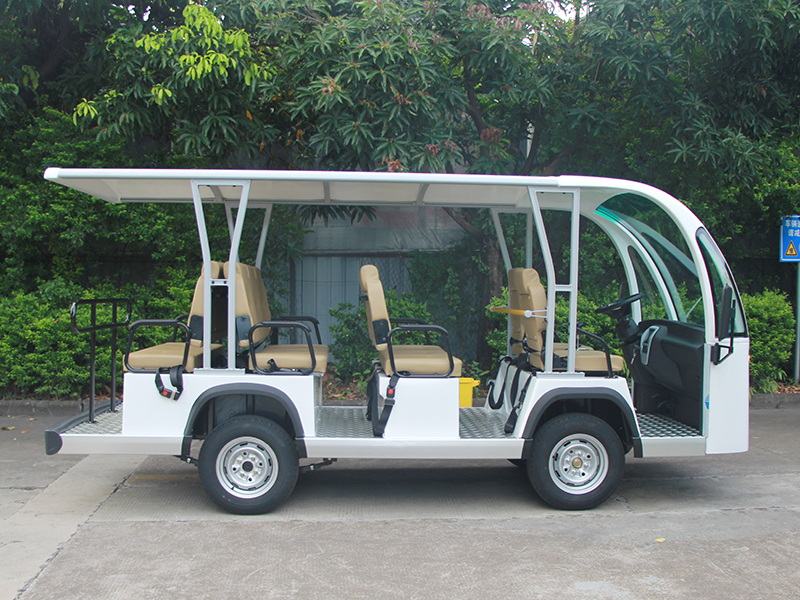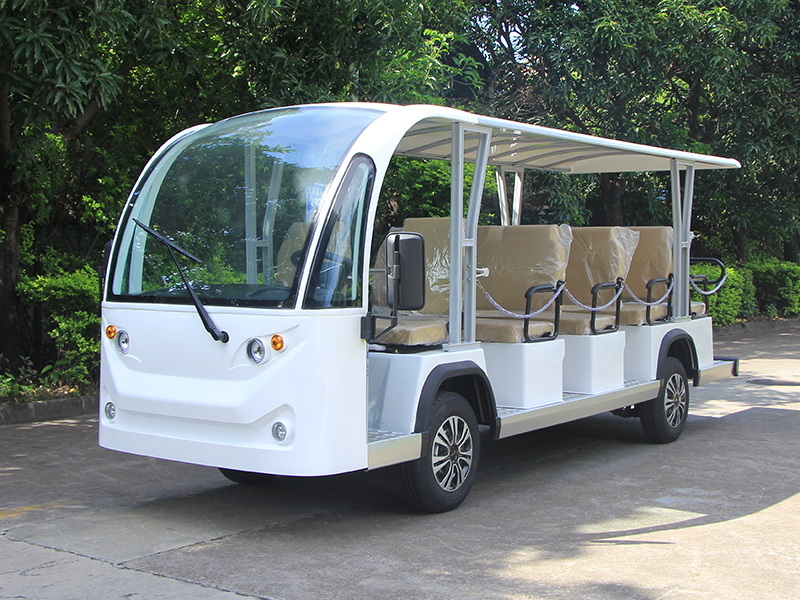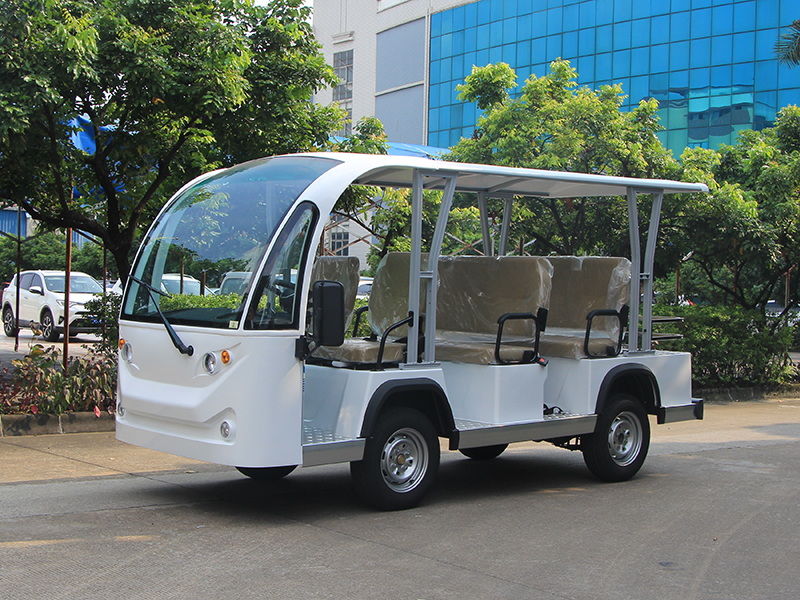Content Menu
● Overview of Electric Tourist Bus Market
● Price Range of Electric Tourist Buses from Leading Manufacturers
● Factors Influencing the Cost of Electric Tourist Buses
>> Battery Capacity and Type
>> Bus Size and Seating Capacity
>> Manufacturer Certifications and Quality Standards
>> Customization and Features
>> Production Scale and Location
● Leading Electric Tourist Bus Manufacturers and Their Offerings
>> 1. Guangzhou Langqing Electric Car Co., Ltd.
>> 2. Sichuan Weilang New Energy Electric Vehicle Co., Ltd.
>> 3. Guizhou Zhonghui Heavy Industry Co., Ltd.
>> 4. Guangdong Marshell Electric Vehicle Co., Ltd.
>> 5. Shandong Chuanliang New Energy Technology Co., Ltd.
● Technical Features Affecting Cost and Performance
>> Battery Technology
>> Motor and Controller
>> Build Materials and Safety
>> Speed and Range
● Total Cost of Ownership and Economic Considerations
● Conclusion
● FAQ
>> 1. What is the typical price range for electric tourist buses?
>> 2. How does battery technology affect the cost?
>> 3. Are electric tourist buses cheaper to operate than diesel buses?
>> 4. Which manufacturers are leading in electric tourist bus production?
>> 5. What certifications should I look for when buying an electric tourist bus?
Electric tourist buses are gaining momentum globally as eco-friendly, cost-efficient alternatives to traditional diesel-powered buses. For operators and tourism companies looking to invest in electric tourist buses, understanding the cost structure and options available from top manufacturers is crucial. This comprehensive article explores the pricing landscape, key manufacturers, technical features, and factors influencing the cost of electric tourist buses.

Overview of Electric Tourist Bus Market
Electric tourist buses are designed specifically for sightseeing and shuttle services, offering zero emissions, quieter operation, and lower operating costs. The market includes various manufacturers primarily based in China and Europe, offering a range of models with different seating capacities, battery technologies, and driving ranges. These vehicles are increasingly favored in environmentally sensitive areas such as national parks, historic city centers, and resorts where noise and air pollution must be minimized.
The global push toward sustainability, coupled with stricter emissions regulations, has accelerated the adoption of electric buses in the tourism sector. Governments and local authorities often provide incentives or subsidies to encourage the switch from fossil fuel-powered vehicles to electric alternatives, thereby influencing the purchasing decisions of operators.
Price Range of Electric Tourist Buses from Leading Manufacturers
Prices for electric tourist buses vary significantly depending on size, battery capacity, features, and manufacturer reputation. Below is a summary of price ranges from some top electric tourist bus manufacturers:
- Guangzhou Langqing Electric Car Co., Ltd. offers electric sightseeing buses priced between US$6,650 to US$6,800 per piece, with a minimum order quantity (MOQ) of 2 pieces. These buses typically feature steel frameworks and laminated windshields, designed for durability and safety.
- Sichuan Weilang New Energy Electric Vehicle Co., Ltd. provides 14-seat closed electric sightseeing buses priced between US$7,500 to US$8,500 per piece, MOQ 1 piece. Their models come equipped with 72V, 7.5 kW AC motors and are capable of gradeability between 20-30%, making them suitable for hilly tourist routes.
- Guizhou Zhonghui Heavy Industry Co., Ltd. lists prices ranging from US$8,600 to US$11,180 per piece, MOQ 1 piece. This manufacturer emphasizes quality and safety certifications, offering buses with advanced battery management systems.
- Guangdong Marshell Electric Vehicle Co., Ltd. offers 23-seater mini open city electric tourist shuttle buses priced between US$6,800 to US$12,000 per piece. Their vehicles are popular in airport and resort shuttle services due to their spacious seating and reliable lithium battery packs.
- Shandong Chuanliang New Energy Technology Co., Ltd. sells electric sightseeing mini buses with a price range of US$5,850 to US$7,500 per piece, MOQ 2 pieces. Their buses focus on long-range lithium iron phosphate (LFP) batteries and efficient energy use.
- Guangzhou Ruike Electric Vehicle Co., Ltd. prices their electric buses between US$8,500 to US$8,900 per unit, MOQ 1 unit. They provide options with various battery capacities and emphasize fast delivery and after-sales support.
These prices reflect a wide range of options, from smaller 14-seat buses to larger 23-seat models, with variations in battery technology, build quality, and included features.
Factors Influencing the Cost of Electric Tourist Buses
Several factors affect the purchase price of electric tourist buses:
Battery Capacity and Type
The most significant component influencing cost is the battery. Lithium-ion batteries, especially Lithium Iron Phosphate (LFP) types, are widely used for their balance of safety, longevity, and cost. Larger battery packs increase vehicle range but also add weight and expense. Advances in battery technology are gradually reducing costs, but battery replacement remains a major long-term expense.
Bus Size and Seating Capacity
The physical size and passenger capacity directly impact the price. Larger buses require more materials, stronger chassis, and bigger motors, all of which increase costs. For example, a 23-seater bus will generally cost nearly twice as much as a 14-seater due to these factors.
Manufacturer Certifications and Quality Standards
ISO certifications such as ISO9001 (quality management), ISO14001 (environmental management), and ISO45001 (occupational health and safety) indicate a manufacturer's commitment to quality and safety. Buses from certified manufacturers often come with better warranties and after-sales service, which can justify a higher price.
Customization and Features
Additional features such as air conditioning, advanced motor controllers, laminated windshields, steel frameworks, and onboard infotainment systems increase the upfront price. Custom paint jobs, branding, and interior layouts tailored to specific tourism needs also add to costs.
Production Scale and Location
Manufacturers with large-scale production capabilities and those located in regions with lower manufacturing costs (notably China) can offer more competitive pricing. However, import duties, shipping costs, and local taxes can affect the final purchase price in different countries.

Leading Electric Tourist Bus Manufacturers and Their Offerings
1. Guangzhou Langqing Electric Car Co., Ltd.
Guangzhou Langqing specializes in electric sightseeing buses with robust steel frameworks designed for durability in various environments. Their buses are equipped with laminated windshields and offer a good balance of price and quality. The company is ISO9001 and ISO14001 certified, ensuring compliance with international quality and environmental standards. They emphasize fast delivery and competitive pricing, making them a popular choice for operators needing reliable electric tourist buses quickly.
2. Sichuan Weilang New Energy Electric Vehicle Co., Ltd.
Sichuan Weilang produces 14-seat closed electric sightseeing buses powered by 72V, 7.5 kW AC motors. Their vehicles are designed for moderate off-road gradeability (20-30%), making them suitable for tourist routes with hills or uneven terrain. The company focuses on steel frameworks and quality battery packs, offering a price range of US$7,500 to US$8,500 per unit. Their buses are favored for small group tours and urban sightseeing.
3. Guizhou Zhonghui Heavy Industry Co., Ltd.
Guizhou Zhonghui offers a variety of electric buses with prices ranging from US$8,600 to US$11,180. They hold multiple certifications including ISO9001, ISO45001, and ISO14001, which reflect their commitment to quality, safety, and environmental responsibility. Their electric tourist buses come with advanced battery management systems and are known for reliability and comfort. The company supports secure trading and has been audited by third-party organizations, providing buyers with confidence in product quality.
4. Guangdong Marshell Electric Vehicle Co., Ltd.
Guangdong Marshell manufactures 23-seater mini open city electric tourist shuttle buses, often used for airport and resort transport. Their vehicles utilize lithium batteries for extended range and reliability, with prices ranging from US$6,800 to US$12,000. The company is known for customization options and robust after-sales service. Their buses combine spacious seating with efficient electric drivetrains, making them popular in high-traffic tourist areas.
5. Shandong Chuanliang New Energy Technology Co., Ltd.
Shandong Chuanliang focuses on electric sightseeing mini buses equipped with long-range LFP lithium batteries. Their price range of US$5,850 to US$7,500 makes them attractive for small to medium-sized tourism operators. The company emphasizes energy efficiency and durability, with a minimum order quantity of 2 pieces. Their buses are often used in parks, resorts, and urban sightseeing circuits.
Technical Features Affecting Cost and Performance
Battery Technology
Lithium Iron Phosphate (LFP) batteries dominate the electric tourist bus market due to their safety, long cycle life, and thermal stability. Although slightly heavier than other lithium-ion chemistries, LFP batteries provide a good balance of cost and performance. Battery capacity typically ranges from 20 kWh to 60 kWh or more, directly influencing the driving range, which can vary from 80 km to over 200 km per charge depending on usage.
Motor and Controller
Electric tourist buses commonly use AC motors paired with advanced motor controllers that regulate power delivery for smooth acceleration and efficient energy use. Motor power ratings generally range from 7.5 kW to 15 kW or higher, depending on vehicle size. Efficient controllers improve battery life by optimizing energy consumption during stop-and-go city driving.
Build Materials and Safety
Most electric tourist buses feature welded steel frameworks for structural integrity and safety. Laminated windshields and reinforced body panels protect passengers while maintaining visibility. The use of corrosion-resistant materials extends vehicle life in humid or coastal environments.
Speed and Range
Electric tourist buses typically have a maximum speed of around 30 km/h, sufficient for urban and park environments where safety and noise reduction are priorities. Range depends on battery size, passenger load, terrain, and climate control usage, with typical ranges between 80 km and 150 km on a single charge.
Total Cost of Ownership and Economic Considerations
While upfront costs for electric tourist buses can be higher than diesel counterparts, the total cost of ownership (TCO) is often lower due to several factors:
- Reduced Fuel Costs: Electricity is generally cheaper and more stable in price than diesel fuel.
- Lower Maintenance Costs: Electric drivetrains have fewer moving parts, reducing wear and tear and maintenance frequency.
- Government Incentives: Many regions offer subsidies, tax breaks, or grants for electric vehicle purchases.
- Longer Vehicle Lifespan: Proper battery management and fewer mechanical failures extend the usable life of electric buses.
- Environmental Benefits: Reduced emissions contribute to corporate social responsibility goals and may improve brand image.
Operators should consider not only the purchase price but also charging infrastructure costs, battery replacement schedules, and operational savings when evaluating electric tourist buses.
Conclusion
Purchasing an electric tourist bus from top manufacturers involves evaluating upfront costs, technical specifications, and long-term economic benefits. Prices vary widely, from approximately US$5,850 for smaller models to over US$12,000 for larger, feature-rich buses. Leading manufacturers such as Guangzhou Langqing, Sichuan Weilang, and Guizhou Zhonghui provide a range of options tailored to different operational needs. As battery technology advances and production scales increase, electric tourist buses are becoming increasingly cost-competitive, making them a smart investment for sustainable tourism. Operators should carefully assess their route requirements, passenger capacity needs, and budget constraints to select the best model and manufacturer.

FAQ
1. What is the typical price range for electric tourist buses?
Prices range from about US$5,850 to US$12,000 depending on size, battery capacity, and manufacturer.
2. How does battery technology affect the cost?
Lithium-ion and LFP batteries are common; larger capacity batteries increase cost but extend range and longevity.
3. Are electric tourist buses cheaper to operate than diesel buses?
Yes, electric buses have lower fuel and maintenance costs, often resulting in a lower total cost of ownership despite higher upfront prices.
4. Which manufacturers are leading in electric tourist bus production?
Top manufacturers include Guangzhou Langqing, Sichuan Weilang, Guizhou Zhonghui, Guangdong Marshell, and Shandong Chuanliang.
5. What certifications should I look for when buying an electric tourist bus?
ISO9001, ISO14001, and ISO45001 certifications indicate quality management, environmental standards, and occupational health and safety compliance.










































